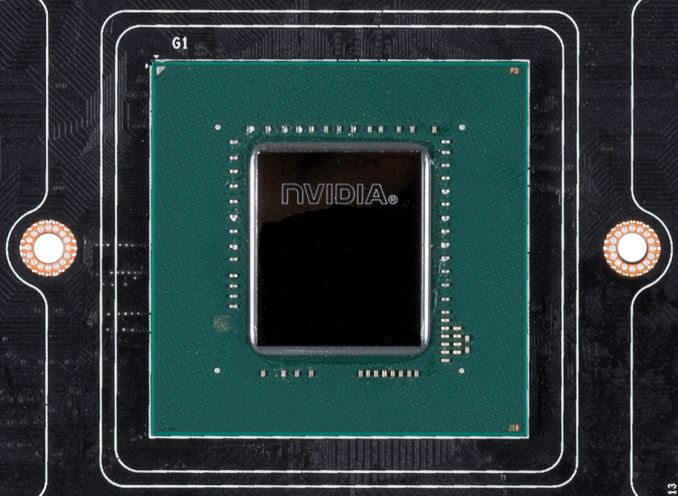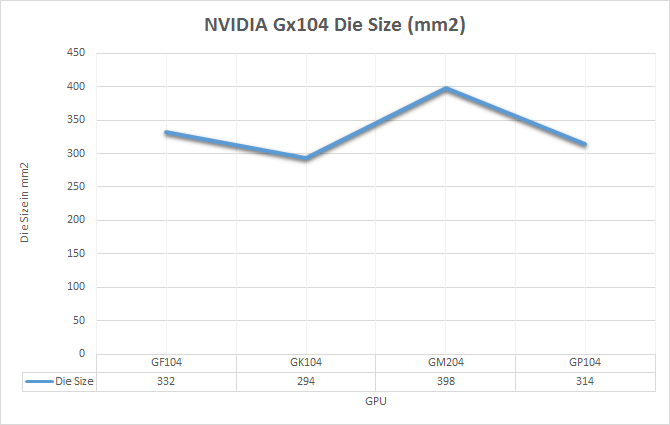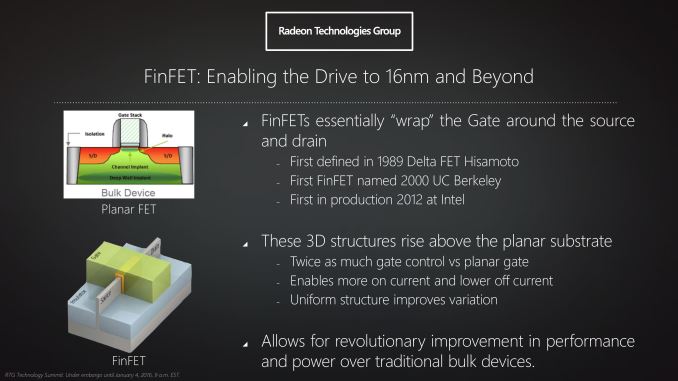The NVIDIA GeForce GTX 1080 & GTX 1070 Founders Editions Review: Kicking Off the FinFET Generation
by Ryan Smith on July 20, 2016 8:45 AM ESTGP104: The Heart of GTX 1080
At the heart of the GTX 1080 is the first of the consumer-focused Pascal GPUs, GP104. Though no two GPU generations are ever quite alike, GP104 follows a number of design cues established with the past couple 104 GPUs. Overall 104 GPUs have struck a balance between size and performance, allowing NVIDIA to get a suitably high yielding GPU out at the start of a generation, and to be followed up with larger GPUs later on as yields improve. With the exception of the GTX 780, 104 GPUs been the backbone of NVIDIA’s GTX 70 and 80 parts, and that is once again the case for the Pascal generation.
In terms of die size, GP104 comes in at 314mm2. This is right in NVIDIA’s traditional sweet spot for these designs, slotting in between the 294mm2 GK104 and the 332mm2 GF104. In terms of total transistors we’re looking at 7.2B transistors, up from 3.5B on GK104 and the 5.2B of the more unusual GM204. The significant increase in density comes from the use of TSMC’s 16nm FinFET process, which compared to 28nm combines a full node shrink, something that has been harder and harder to come by as the years have progressed.
Though the density improvement offered by TSMC’s 16nm process is of great importance to GP104’s overall performance, for once density takes a back seat to the properties of the process itself. I am of course speaking about the FinFET transistors, which are the headlining feature of TSMC’s process.
We’ve covered FinFET technology in depth before, so I won’t completely rehash it here. But in brief, FinFETs are an important development for chip fabrication as processes have gone below 28nm. As traditional, planar transistors have shrunk in feature size – and ultimately, the number of atoms they’re comprised of – electrical leakage has increased. With fewer atoms in a transistor, there are equally fewer atoms to control the flow of electrons.
FinFET in turn is a solution to this problem, essentially allowing fabs to turn back the clock on electrical leakage. By building transistors as three-dimensional objects with height as opposed to two-dimensional objects, giving FinFET transistors their characteristic fins in the process, FinFET technology greatly reduces the amount of energy a transistor leaks. In practice what this means is that FinFET technology not only reduces the total amount of energy wasted from leakage, but it also allows transistors to be operated at a much lower voltage, something we’ll see in depth with our analysis of GTX 1080.
FinFETs, or rather the lack thereof, are a big part of why we never saw GPUs built on TSMC’s 20nm process. It was TSMC’s initial belief that they could contain leakage well enough using traditional High-K Metal Gate (HKMG) technology on 20nm, a bet they ultimately lost. At 20nm, planar transistors were just too leaky to use for many applications, which is why ultimately we only saw SoCs on 20nm (and even then they were suboptimal). FinFETs, as it turns out, are absolutely necessary to get good performance out of transistors built on processes below 28nm.
And while it took TSMC some time to get there, now that they have the capability NVIDIA can reap the benefits. Not only can NVIDIA finally build a relatively massive chip like a GPU on a sub-28nm process, but thanks to the various beneficial properties of FinFETs, it allows them to take their designs in a different direction than what they could do on 28nm.













200 Comments
View All Comments
Eidigean - Wednesday, July 20, 2016 - link
Excellent article Ryan.Will you be writing a followup article with tests of two GTX 1080's in SLI with the new high-bandwidth dual bridge?
Looking specifically for these tests in SLI:
3840x2160
2560x1440
3x 2560x1440 (7680x1440)
3x 1920x1080 (5760x1080)
Hoping the latter two tests would include with and without multi-projection optimizations.
Thanks!
Ryan Smith - Wednesday, July 20, 2016 - link
"Will you be writing a followup article with tests of two GTX 1080's in SLI with the new high-bandwidth dual bridge?"It's on the schedule. But not in the near term, unfortunately. GPU Silly Season is in full swing right now.
big dom - Wednesday, July 20, 2016 - link
I agree with the previous reviewers. It's fine and dandy to be a "day one" breakthrough reviewer and believe me I read and enjoyed 20 of those other day 1 reviews as well. But... IMO no one writes such an in depth, technical, and layman-enjoyable review like Anandtech. Excellent review fellas!This is coming from a GTX 1070 FE owner, and I am also the other of the original Battleship Mtron SSD article.
Regards,
Dominick
big dom - Wednesday, July 20, 2016 - link
*authorjase240 - Wednesday, July 20, 2016 - link
I don't understand why in your benchmarks the framerates are so low. For example I have a 1070 and am able to play GTAV at very high settings and achieve 60fps constant at 4K.(No MSAA obviously)Even other reviewers have noted much higher framerates. Listing the 1080 as a true 4K card and the 1070 as a capable 4K card too.
Ryan Smith - Wednesday, July 20, 2016 - link
It depends on the settings.The way I craft these tests is settings centric. I pick the settings and see where the cards fall. Some other sites have said that they see what settings a card performs well at (e.g. where it gets 60fps) and then calibrate around that.
The end result is that the quality settings I test are most likely higher than the sites you're comparing this article to.
jase240 - Wednesday, July 20, 2016 - link
Ah now I see why, you have the advanced graphics settings turned up also. These are not turned on by default in GTAV since they cause great performance loss.Extended Distance Scaling, Extended Shadows Distance, Long Shadows, High Resolution Shadows, High Detail Streaming While Flying.
They eat a lot of VRAM and perform terribly at higher resolutions.
sonicmerlin - Thursday, July 21, 2016 - link
And I'm guessing add very little to overall picture quality.Mat3 - Wednesday, July 20, 2016 - link
I think there's something wrong with your Fury X in a couple of your compute tests. How's it losing to a Nano?masouth - Wednesday, July 20, 2016 - link
I know the article was posted today but when was it actually written? NewEgg has been having the dual fan Gigabyte GTX 1070 at $399 for a couple weeks now. Yes, it's still $20 over the MSRP and frequently sells out as quick as they show up but it's still a fair deal cheaper than $429.